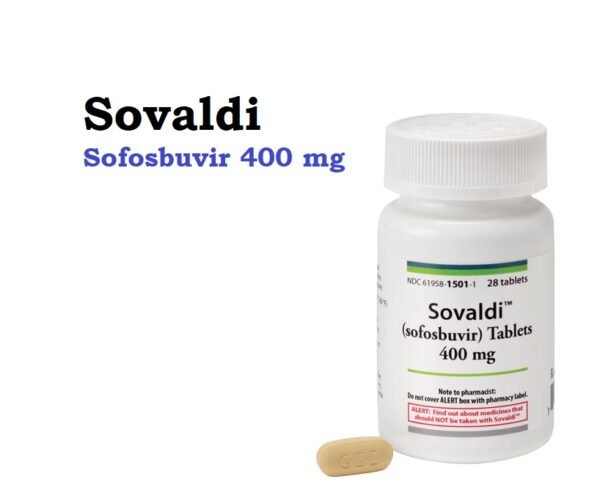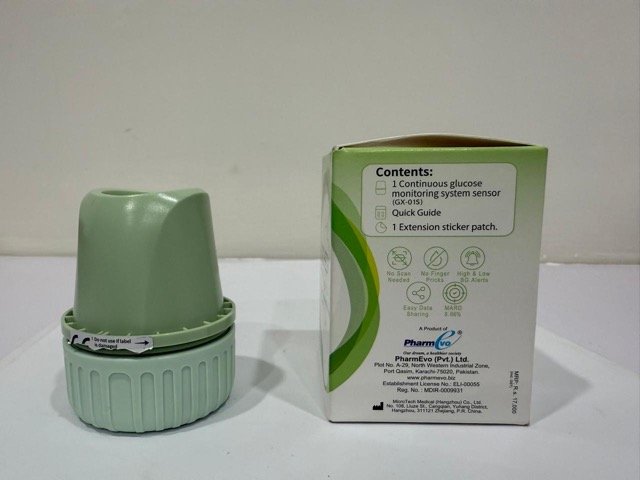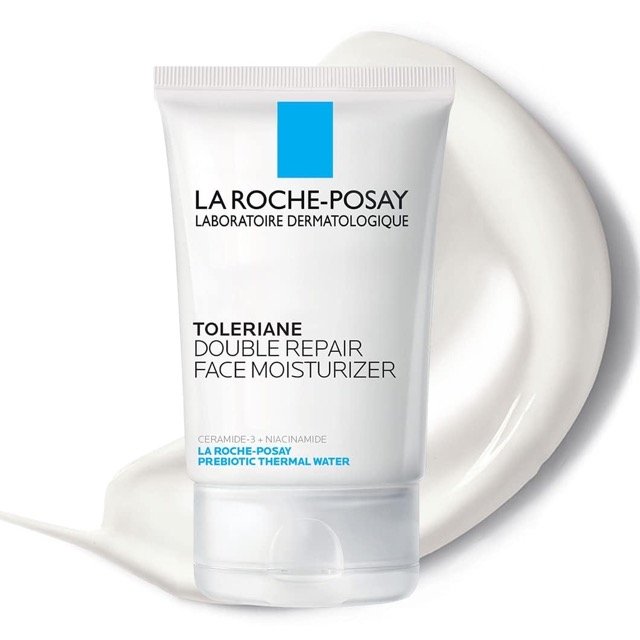Sovaldi (Sofosbuvir) is a direct-acting orally available antiviral drug that is used in the treatment of chronic hepatitis C infection.
Sofosbuvir (Sovaldi) Uses:
-
Chronic hepatitis C:
- In adults, treatment of genotype 1, 2, 3, or 4 chronic hepatitis C virus (HCV) infection and genotype 2 or 3 chronic HCV infection in pediatric patients ≥12 years or weighing ≥35 kg, without cirrhosis or with compensated cirrhosis, as a component of a combination antiviral treatment regimen.
-
Use: Off-Label: Adult
- Chronic hepatitis C, genotype 1, 2, 3, or 4 (decompensated cirrhosis).
- Chronic hepatitis C, genotype 1, 2, 3, 4, 5, or 6 (liver transplant recipients).
- Chronic hepatitis C, genotype 2, 3, 5, or 6 (renal transplant recipients)
See also: Sofosbuvir + Velpatasvir (Epclusa)
-
Sofosbuvir (Sovaldi) Dose in Adults
Sofosbuvir (Sovaldi) Dose in the treatment of Chronic hepatitis C (CHC) infection (mono infection or coinfected with HIV-1): P/O:
Note:
- Treatment-experienced refers to patients who have failed prior treatment with peginterferon and ribavirin.
- With ribavirin, combination therapy alone or ribavirin/peginterferon is not a recommended regimen in HCV treatment guidelines for patients with HCV (treatment-naive or treatment-experienced), regardless of genotype.
-
Genotype 1:
-
Treatment-naive or peginterferon + ribavirin treatment-experienced patients without cirrhosis (alternative regimen):
- For 12 weeks, 400 mg once daily in combination with simeprevir or daclatasvir.
-
Patients with decompensated cirrhosis (Child-Pugh class B or C) (off-label use):
- For 12 weeks, 400 mg once daily in combination with daclatasvir and ribavirin (if ribavirin-ineligible give in combination with daclatasvir only for 24 weeks).
-
Liver transplant recipients without cirrhosis or with compensated cirrhosis (Child-Pugh class A) (alternative regimen) (off-label use):
- For 12 weeks, 400 mg once daily, in combination with daclatasvir and ribavirin or simeprevir with or without ribavirin.
-
Manufacturer’s labeling:
- In the prescribing information, dosing may not reflect current clinical practice.
-
Treatment-naive patients without cirrhosis or with compensated cirrhosis (Child-Pugh class A):
- For 12 weeks, 400 mg once daily with concomitant peginterferon alfa and ribavirin.
- Administer with concomitant ribavirin for 24 weeks, for patients that cannot receive peginterferon alfa.
-
-
Genotype 2:
-
Treatment-naive or peginterferon + ribavirin treatment-experienced patients (alternative regimen):
- For 12 weeks (without cirrhosis) or 16 to 24 weeks (with compensated cirrhosis [Child-Pugh class A]), 400 mg once daily in combination with daclatasvir.
-
Patients with decompensated cirrhosis (Child-Pugh class B or C) (off-label use):
- For 12 weeks, 400 mg once daily in combination with daclatasvir and ribavirin (if ribavirin-ineligible give in combination with daclatasvir only for 24 weeks) (AASLD/IDSA 2017)
-
Liver transplant recipients with or without cirrhosis, including decompensated cirrhosis (Child-Pugh class B or C) (off-label use):
- For 12 weeks, 400 mg once daily in combination with daclatasvir and ribavirin.
-
Renal transplant recipients without cirrhosis or with compensated cirrhosis (Child-Pugh class A) (alternative regimen) (off-label use):
- For 12 weeks, 400 mg once daily in combination with daclatasvir and ribavirin.
-
Manufacturer’s labeling:
- Dosing in the prescribing information may not reflect current clinical practice.
-
Treatment-naive and treatment-experienced patients without cirrhosis or with compensated cirrhosis (Child-Pugh class A):
- For 12 weeks, 400 mg once daily with concomitant ribavirin.
-
-
Genotype 3:
-
Treatment-naive or peginterferon + ribavirin treatment-experienced patients without cirrhosis (alternative regimen):
- For 12 weeks, 400 mg once daily in combination with daclatasvir.
-
Treatment-naive patients with compensated cirrhosis (Child-Pugh class A) (alternative regimen):
- For 24 weeks, 400 mg once daily in combination with daclatasvir with or without ribavirin.
-
Patients with decompensated cirrhosis (Child-Pugh class B or C) (off-label use):
- For 12 weeks, 400 mg once daily in combination with daclatasvir and ribavirin (if ribavirin-ineligible give in combination with daclatasvir only for 24 weeks).
-
Liver transplant recipients with or without cirrhosis, including decompensated cirrhosis (Child-Pugh class B or C) (off-label use):
- For 12 weeks, 400 mg once daily in combination with daclatasvir and ribavirin.
-
Renal transplant recipients without cirrhosis or with compensated cirrhosis (Child-Pugh class A) (alternative regimen) (off-label use):
- For 12 weeks, 400 mg once daily in combination with daclatasvir and ribavirin.
-
Manufacturer’s labeling:
- Dosing in the prescribing information may not reflect current clinical practice.
- Treatment-naive or treatment-experienced patients without cirrhosis or with compensated cirrhosis (Child-Pugh class A):
- For 24 weeks, 400 mg once daily with concomitant ribavirin.
-
-
Genotype 4:
-
Patients with decompensated cirrhosis (Child-Pugh class B or C) (off-label use):
- For 12 weeks, 400 mg once daily in combination with daclatasvir and ribavirin (if ribavirin-ineligible give in combination with daclatasvir only for 24 weeks).
-
Liver transplant recipients without cirrhosis or with compensated cirrhosis (Child-Pugh class A) (alternative regimen) (off-label use):
- For 12 weeks, 400 mg once daily, in combination with daclatasvir and ribavirin or simeprevir with or without ribavirin.
-
Manufacturer’s labeling:
- Dosing in the prescribing information may not reflect current clinical practice.
-
Treatment-naive patients without cirrhosis or with compensated cirrhosis (Child-Pugh class A):
- For 12 weeks, 400 mg once daily with concomitant peginterferon alfa and ribavirin.
-
-
Genotypes 5 and 6 (AASLD/IDSA 2017):
-
Liver transplant recipients without cirrhosis or with compensated cirrhosis (Child-Pugh class A) (alternative regimen) (off-label use):
- For 12 weeks, 400 mg once daily in combination with daclatasvir and ribavirin.
-
Renal transplant recipients without cirrhosis or with compensated cirrhosis (Child-Pugh class A) (alternative regimen) (off-label use):
- For 12 weeks, 400 mg once daily in combination with daclatasvir and ribavirin.
-
Sofosbuvir (Sovaldi) Dose in Children
Sofosbuvir (Sovaldi) Dose in the treatment of Chronic hepatitis C infection (mono-infection or coinfected with HIV-1):
Treatment-naive or treatment-experienced without cirrhosis or with compensated cirrhosis (Child-Pugh class A):
Note:
- Treatment-experienced refers to patients who have failed prior treatment with an interferon-based regimen with or without ribavirin.
-
Children ≥12 years or weighing ≥35 kg and Adolescents:
-
Genotype 2:
- P/O:
- For 12 weeks, 400 mg once daily with concomitant ribavirin.
- P/O:
-
Genotype 3:
- P/O:
- For 24 weeks, 400 mg once daily with concomitant ribavirin.
- P/O:
-
Sofosbuvir (Sovaldi) Pregnancy Risk Category: B
- Sofosbuvir should not be used as a monotherapy.
- Combination therapy with Ribavirin is not recommended for pregnant females or males whose partners are pregnant.
- If ribavirin is used together with it, all warnings regarding pregnancy and contraception must be observed.
- Refer to the ribavirin monograph for additional information.
- Treatment of hepatitis C during pregnancy is not recommended to treat maternal infections or reduce the chance of mother-to child transmission.
- HCV-infected women with childbearing potential who are not yet on treatment to reduce the risk of HCV transmission should postpone pregnancy.
- If HCV infection is discovered during pregnancy, treatment should be delayed until after delivery.
- Direct-acting antiviral medication should not be administered to pregnant women unless safety and efficacy data are available.
Sofosbuvir use during breastfeeding:
- It is unknown if sofosbuvir can be found in breast milk.
- When deciding whether to discontinue or continue breastfeeding during therapy, it is important to consider the risks to infants, the benefits to the mother, and the benefits to the mother.
- The spread of the hepatitis C viruses is not associated with breastfeeding.
- Breastfeeding is not recommended if the nipples crack or are bleeding. Milk should be expressed and discarded.
- Breastfeeding is not recommended in the case of HIV co-infection.
Sofosbuvir (Sovaldi) Dose in Kidney Disease:
-
Estimated glomerular filtration rate (eGFR) ≥30 mL/min:
- No dosage adjustment is necessary.
-
eGFR <30 mL/min:
- In the manufacturer's labeling, there are no dosage adjustments provided (has not been studied).
- Predominant metabolite accumulates in impaired renal function.
-
End-stage renal disease (ESRD), including hemodialysis patients:
- In the manufacturer's labeling, there are no dosage adjustments provided (has not been studied).
- Predominant metabolite accumulates in impaired renal function.
Sofosbuvir (Sovaldi) Dose in Liver disease:
- Mild, moderate, or severe impairment (Child-Pugh class A, B, or C):
- No dosage adjustment is necessary.
Common Side Effects of Sofosbuvir (Sovaldi):
-
Central Nervous System:
- Fatigue
- Headache
- Insomnia
- Chills
- Irritability
-
Dermatologic:
- Pruritus
- Skin Rash
-
Gastrointestinal:
- Nausea
- Decreased Appetite
- Diarrhea
-
Hematologic & Oncologic:
- Anemia
- Neutropenia
-
Neuromuscular & Skeletal:
- Asthenia
- Myalgia
-
Respiratory:
- Flu-Like Symptoms
-
Miscellaneous:
- Fever
Less Common Side Effects of Sofosbuvir (Sovaldi):
-
Gastrointestinal:
- Increased Serum Lipase
-
Hematologic & Oncologic:
- Thrombocytopenia
-
Hepatic:
- Increased Serum Bilirubin
-
Renal:
- Increased Creatine Phosphokinase
Contraindications to Sofosbuvir (Sovaldi):
- There are no contraindications in the manufacturer's labeling.
- When administered with ribavirin or peginterferon, the contraindications apply.
- See Ribavirin and Peginterferon Alfa monographs.
Canadian labeling:Additional contraindications not listed in the US labeling:
- Hypersensitivity to sofosbuvir and any component of the formulation
- Female partners who are male may fall pregnant with their female partners
Warnings and precautions
-
Diabetes:
- Rapid reduction in hepatitis C viral load during direct-acting antiviral (DAA) therapy for hepatitis C may lead to an improvement in glucose metabolism in patients with diabetes, potentially resulting in symptomatic hypoglycemia if antidiabetic agents are continued at the same dose.
- Especially in the first three months, assess for changes in glucose tolerance. Inform patients about the possibility of hypoglycemia while on DAA therapy.
- Modifications to anti-diabetic therapy might be required.
-
Hepatitis B virus activation: [US-Boxed Warning]
- Reactivation of the hepatitis B virus has been observed in HCV co-infected patients.
- This was among those who had received or were about to receive direct-acting antivirals for HCV and were not on HBV antiviral therapy.
- Some cases can lead to fulminant liver disease, hepatic failure and even death.
- Before starting sofosbuvir treatment, all patients should be tested for evidence of HBV infection.
- Monitor HCV/HBV coinfected patients during treatment and after-treatment follow up for flare-ups or reactivation of HBV.
- If HBV infection is clinically indicated, you should start treatment.
- HBV reactivation can occur in HBsAg-positive patients as well as patients with confirmed HBV infection (i.e. HBsAg nil and anti-HBc p).
- This is characterized in part by an abrupt rise in HBV replication and a rapid rise in serum HBV DNA levels.
- Patients with a resolved HBV infection may experience HBsAg recurrence.
- Patients who are taking immunosuppressants and chemotherapeutic drugs may have a higher risk of HBV reactivation.
Sofosbuvir: Drug Interaction
Note: Drug Interaction Categories:
- Risk Factor C: Monitor When Using Combination
- Risk Factor D: Consider Treatment Modification
- Risk Factor X: Avoid Concomitant Use
Risk Factor C (Monitor therapy). |
|
| Antidiabetic Agents | Antidiabetic Agents may have a greater hypoglycemic effect if they are administered directly with antiviral agents (HCV). |
| Erdafitinib | Increased serum concentrations of P-glycoprotein/ABCB1 Substrates may be possible. |
| Lumacaftor | May lower the serum concentrations of P-glycoprotein/ABCB1 Substrates. Lumacaftor could increase serum levels of P-glycoprotein/ABCB1 Substrates. |
| P-glycoprotein/ABCB1 Inhibitors | Increases serum concentrations of Pglycoprotein/ABCB1 substrates. P-glycoprotein inhibitors can also increase the distribution of pglycoprotein substrates to certain cells/tissues/organs in which p-glycoprotein exists in high amounts (e.g. brain, T-lymphocytes and testes). . |
| Ranolazine | Increased serum concentrations of P-glycoprotein/ABCB1 Substrates may be possible. |
| Tacrolimus (Systemic) | Sofosbuvir could lower the serum concentrations of Tacrolimus, (Systemic). |
| Tenofovir Alafenamide | Tenofovir Alafenamide may be increased by Sofosbuvir. |
| Vitamin K antagonists (eg warfarin) | Antihepaciviral NS5B RNA polymerase inhibitors may decrease the anticoagulant effects of Vitamin K Antagonists. |
Risk Factor X (Avoid Combination) |
|
| Amiodarone | Amiodarone may have a bradycardic effect that Sofosbuvir might enhance. |
| Modafinil | Could lower the serum level of Sofosbuvir. |
| Oxcarbazepine | Could lower the serum level of Sofosbuvir. |
| P-glycoprotein/ABCB1 Inducers | Could lower the serum level of Sofosbuvir. |
| PHENobarbital | Could lower the serum level of Sofosbuvir. |
| Primidone | Could lower the serum level of Sofosbuvir. |
| Rifabutin | Could lower the serum level of Sofosbuvir. |
| Rifapentine | Could lower the serum level of Sofosbuvir. |
| Tipranavir | Could lower the serum level of Sofosbuvir. |
Monitoring parameters:
-
Manufacturer's labeling:
- Bilirubin, liver enzymes, and serum creatinine at baseline and periodically when clinically indicated.
- If used in combination with amiodarone & another direct-acting antiviral (DAA) (or in patients who discontinued amiodarone just prior to initiating sofosbuvir in combination with a DAA), inpatient cardiac monitoring for the first 48 hours of coadministration, then daily outpatient or self-monitoring of heart rate through at least the first two weeks of treatment.
- During treatment, at the end of treatment, during treatment follow-up, and when clinically indicated, serum HCV-RNA at baseline.
- Prior to initiation, Hepatitis B surface antigen (HBsAg) and hepatitis B core antibody (anti-HBc).
- Monitor for clinical and laboratory signs of hepatitis flare or HBV reactivation during treatment and during post-treatment follow-up, in patients with serologic evidence of hepatitis B virus (HBV) infection.
Alternate recommendations:
-
Baseline (within 12 weeks prior to starting antiviral therapy):
- CBC, INR, hepatic function panel (albumin, total and direct bilirubin, ALT, AST & alkaline phosphatase), and calculated GFR.
-
Baseline (at any time prior to starting antiviral therapy):
- HCV genotype & subtype, quantitative HCV viral load.
During therapy:
-
- CBC, serum creatinine, calculated GFR, hepatic function panel (after 4 weeks of therapy, and as clinically indicated).
- Quantitative HCV viral load testing (after 4 weeks of therapy & at 12 weeks after completion of therapy).
- Repeat testing is recommended after 2 additional weeks of treatment if quantitative HCV viral load is detectable at treatment week 4 (treatment week 6).
- Monitor blood glucose and for signs/symptoms of hypoglycemia in patients with diabetes.
How to administer Sofosbuvir (Sovaldi)?
- Administer with or without food.
Mechanism of action of Sofosbuvir (Sovaldi):
- Sofosbuvir is an antiviral agent that acts directly against the hepatitis C viruses. It is a drug that has been converted via intracellular metabolism to its pharmacologically effective form (GS-4611203).
- It acts as a terminator and inhibits HCV-NS5B RNA dependent polymerase.
Notice:
- Pediatric patients aged >=12 years are similar to adults in terms of pharmacokinetic profiles.
Protein binding:
- ~61%-65%
Metabolism:
- Hepatic.
- Forms pharmacologically active nucleoside (uridine) analog triphosphate GS-461203.
- Dephosphorylation results in the formation of nucleoside inactive metabolite GS331007
Half-life elimination:
- 0.4 hours
Time to peak:
- ~0.5-2 hours
Excretion:
- Urine (80%; primarily as metabolite).
- Feces (14%).
International Brands of Sofosbuvir:
- Sovaldi
- Caprisofos
- Grateziano
- Gratisovir
- Hepcee
- Hepcinat
- Hepcivir
- Hopforhep
- HopSo
- Myhep
- Sofgen
- Soforal
- Sovaldi
- Soventa
Sofosbuvir Brand Names in Pakistan:
Sovaldi (Ferozsons)







